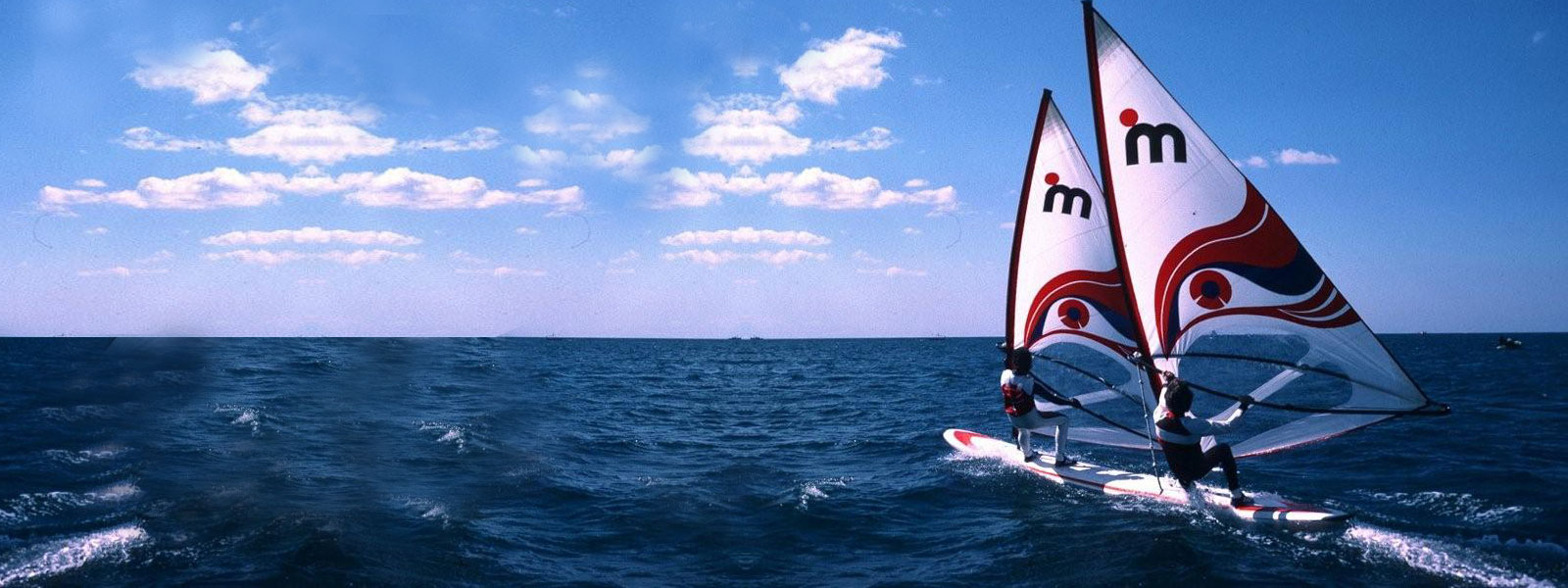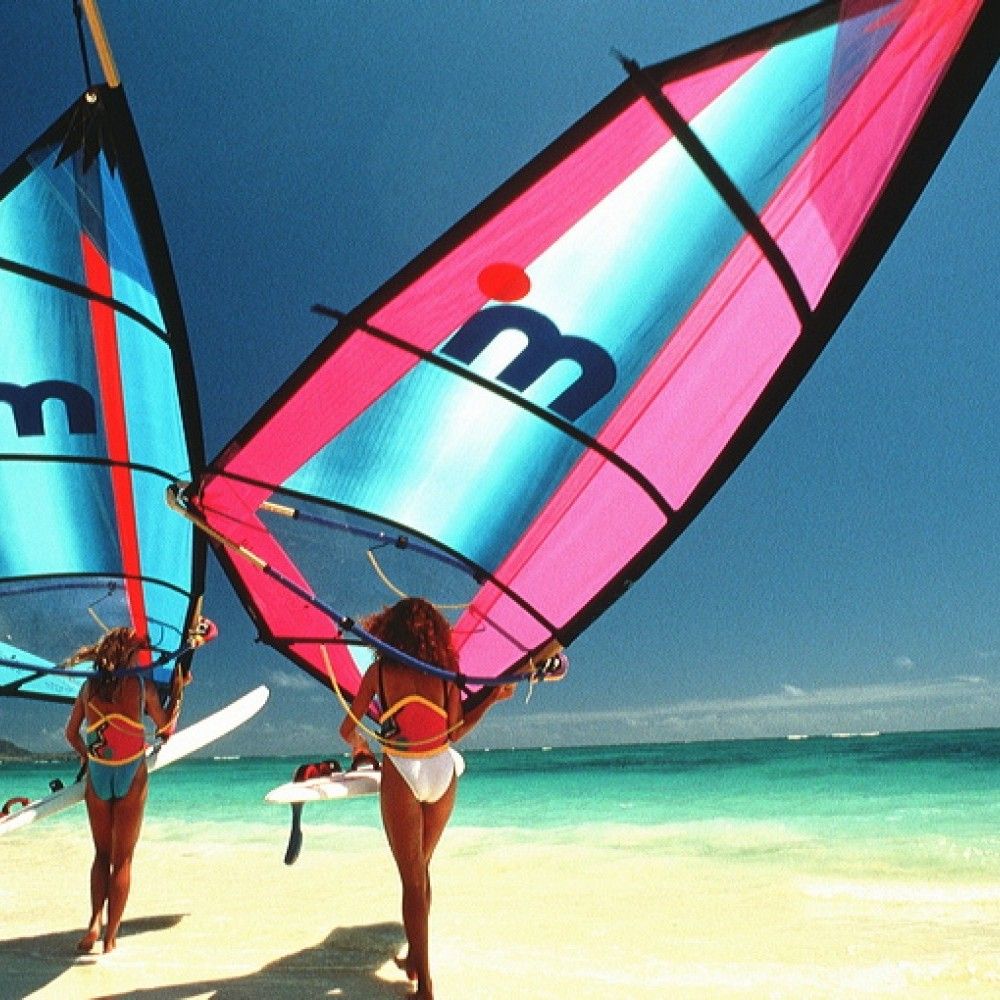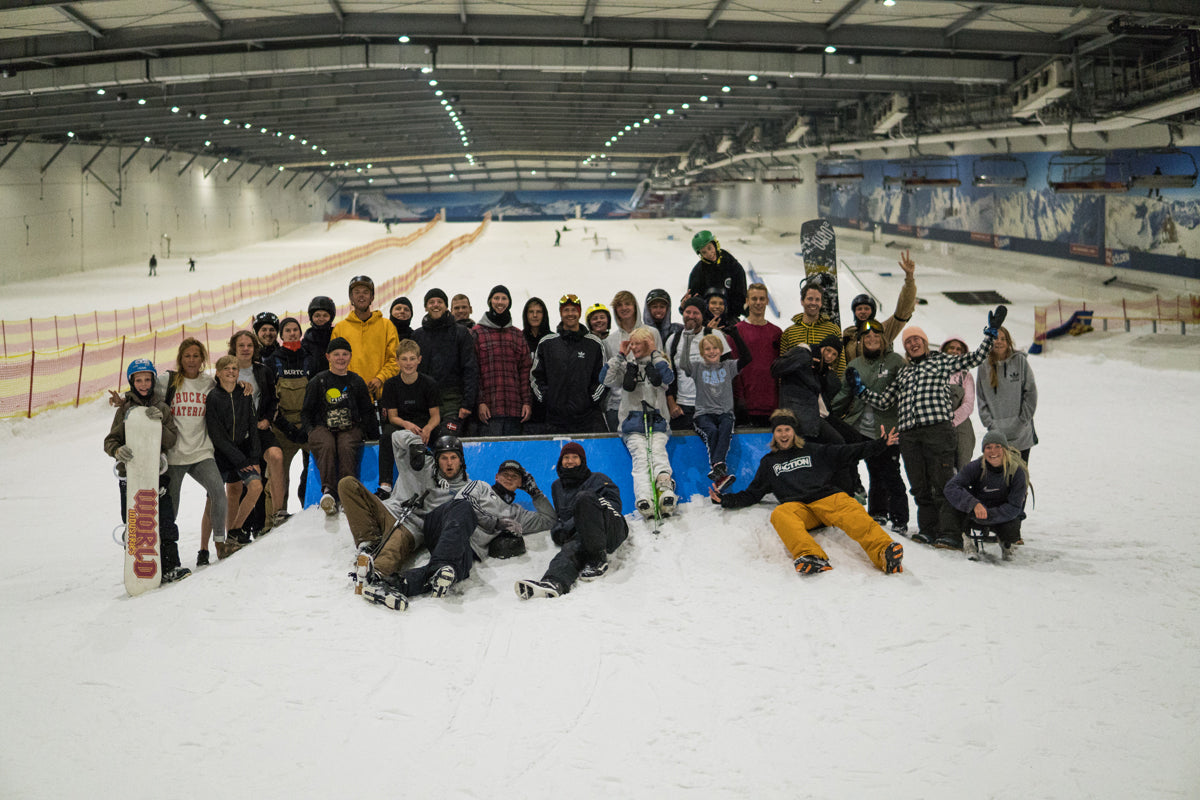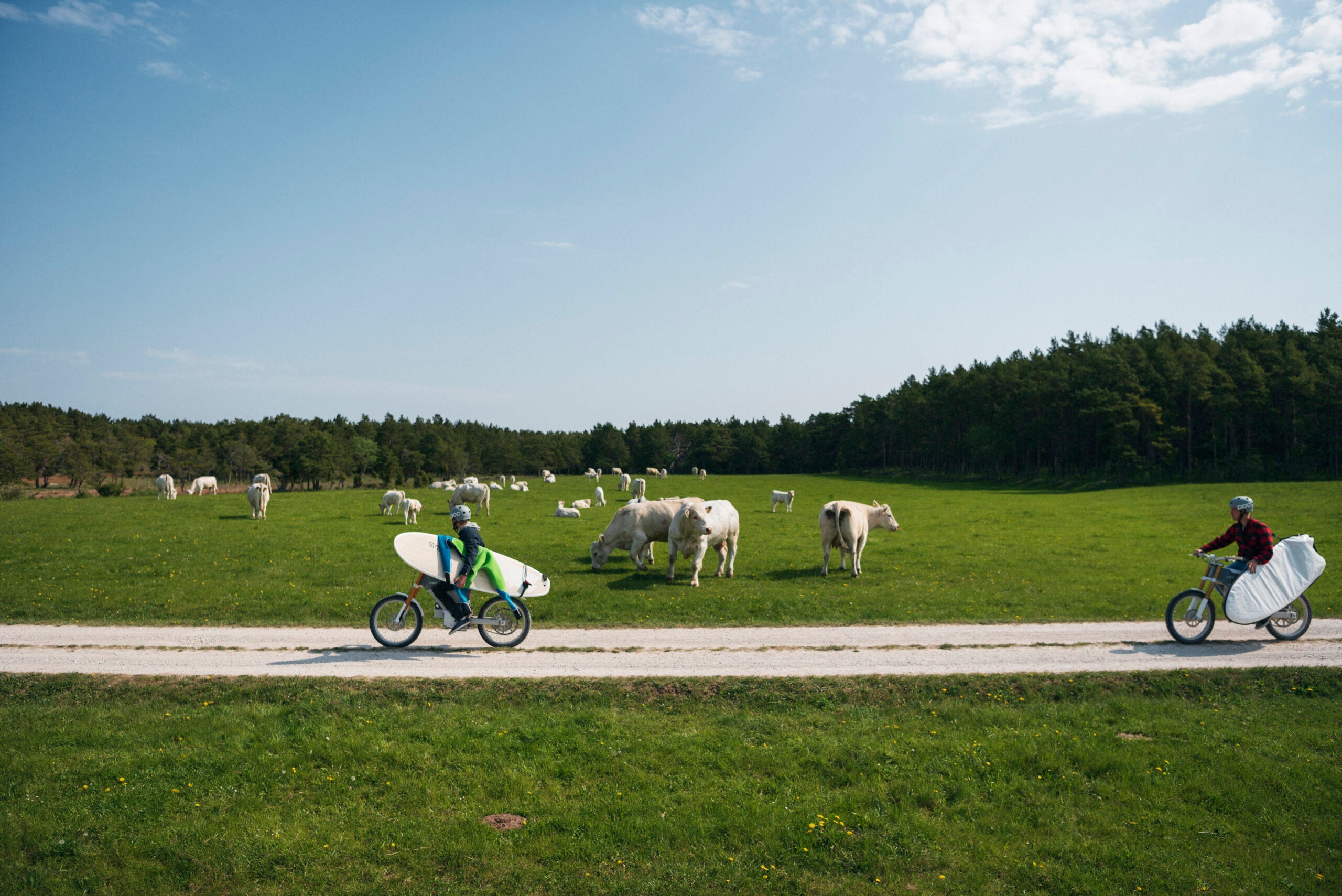
Storhed og fald for windsurfing - er det industriens skyld?
Stuart Thomas og Jason Potts fra School of Economics, Finance and Marketing, RMIT University, Australia har udarbejdet nedenstående artikel som også har fået gang i diskussionerne på Facebook.
I artiklen undersøges en konkurrencedygtig udviklingsproces, som Stuart Thomas og Jason Potts kalder “innovation overshooting” i udstyrsbaseret sport, ved at bruge windsurfing som et casestudie. Nye sportsgrene, især udstyrsbaserede ‘livsstils’ sport, kan opleve en hurtig stigning i popularitet, men til sidst fører teknologidrevet konkurrence til udstyr, der overskrider de fleste brugeres muligheder og finansielle budgetter. Denne Schumpeterian-markedsproces fører til et fald i deltagelsen og den eventuelle sammenbrud af markedet for sportens udstyr. Modeller af endogen overshooting er etableret i studiet af finans- og konjunkturcykluser og er for nylig blevet udvidet til musik- og designindustrien. Stuart Thomas og Jason Potts udvider denne model til sportsudstyrssektoren, hvor der findes klare tegn på evolutionær konkurrencepræget teknologisk og markedsoverskridelse.

How competitive evolutionary dynamics first created then ruined windsurfing
- Introduction
Schumpeterian competition in markets normally drives innovation in particular goods or services along consumer-relevant dimensions: lighter, stronger, faster, cheaper, for instance. We would therefore expect that sporting goods – which are often dependent on materials technology and engineering design that manifestly advance along these dimensions – would be prime candidates for such progressive Schumpeterian evolution. There are clear instances of this: tennis rackets, for instance, now made of graphite and carbon-fibre alloys, are an improvement over aluminum rackets, which are superior to laminated wooden rackets: so lighter, stronger, faster, cheaper. Similarly for bicycles, skis, and at first sight it would seem windsurfing equipment. But the puzzle that we examine in this paper is that this evolutionary dynamic has in reality come closer to destroying windsurfing, among other sports. The explanation for this is the process of ‘overshooting’ in which sports that are significantly dependant on equipment (i.e. most ‘lifestyle’ sports, such as windsurfing, kite-surfing, paddle-boarding or yachting) can get caught in technological ‘arms races’ where oligopolistic Schumpeterian competition at the elite high-performance end results in technological developments that significantly drive up the skill-level and cost of participation (Shah 2000). While this is not a problem at the elite end of the sport, the unintended consequence of this competition is to raise the cost of entry into the sport, thus harming, sometimes catastrophically, its long-run viability. Earl and Potts (2013, 2014), building on Christensen (1997) and Minsky (1986), call this the ‘overshooting hypothesis’ finding it widespread in the creative industries, and in many aspects of consumer engineering.
We will in this case study seek to trace through the consequences of technological overshooting through the trajectory of the sport, understood as an industry composed of a market of recreational and competitive users, manufacturers of equipment, suppliers of services, and complementary goods and services. But we will model the forces driving the industrial dynamics of the sport as the outcome of Schumpeterian or innovation driven technological competition among a small number of equipment manufacturing firms at the elite end of the sport. This study therefore represents a new approach to sports economics as an application of the study of Schumpeterian competition in industrial dynamics. We also develop a new data source built on industry interviews, grey-literature and sports magazines that trace the technological changes, price points, governance concerns, and consumer issues through the trajectory of the industry. Section two reviews the literature on sports innovation, and Section three discuss the method of data capture. Section four presents the history and innovation trajectory of the windsurfing case study based on the primary interview and ‘grey literature’-based data. Section five concludes with discussion of the particular pathologies of competitive innovation in the context of sporting industries, and presents some possible institutional solutions.
- Technological innovation in sports
Central to the technological innovation literature is the idea that innovation takes place in firms because this is where the competences and capabilities required for innovation exist (Schumpeter 1934; Nelson and Winter 1982). This focus on firms has produced many important theoretical insights into the formative years of industry development, including the economic model of ‘product life cycles’ and the sociological literature on organizational fields and populations. In the product life cycle view, technological innovations, often as spillovers, give rise to new industries: firms enter the emerging industry under conditions of technological and market uncertainty and they experiment with various product designs and features to attract and satisfy customers. The combined effort of these firms leads to subsequent market development (Abernathy and Utterback, 1978; Klepper, 1997; Agarwal and Bayus, 2002). The innovating firm in this view, as in the organisational fields and populations view, is the central actor in developing new technologies.
In response to anecdotal evidence from certain sectors of the equipment-driven sports, Shah (2005) argues that existing models that rely solely on firms and research institutions to explain innovation fail to provide insight into the activities of ‘user-innovators’ and the commercial consequences of their activities (also Buenstorf 2003, von Hippel 1986, Lüthje 2004, Lüthje et al 2005). Based on an examination of the boardsports industries (windsurfing, snowboarding, and skateboarding), Shah develops a model that illustrates how everyday innovations and social interactions among users can lead to the formation of firms and markets, beginning with ‘discovery through use.’ As users of products and services encounter new needs, wants, or use contexts (such as the desire to sail faster, or move from flat water sailing to sailing on waves in surf) they modify existing equipment or are motivated to seek out new design and/or construction (Witt 2001). Some work alone, but many users seek out like-minded individuals with whom to collaborate, forming a user innovation community, typically characterized by voluntary participation, free exchange of ideas and innovations and a sense of mutual co-operation. At some point though some of these user-innovators will seek to capitalise on a potential mass market for their invention – or more particularly, the sport or activity that it facilitates – by creating firms to produce and market their goods. Shah finds that the majority of key equipment innovations that are developed prior to the growth of the mass market are made by users and user-manufacturers. An increase in innovative activity by manufacturers occurs only after the mass market begins to grow rapidly and commercial enterprises, sometimes from other sectors, see the market potential of an emerging sport (Shah and Tripas 2007, Shah and Mody 2014). This manufacturer activity is often devoted to solving known problems for users or refining the performance characteristics of existing products – such as adding footstraps to a sailboard to allow a user to jump waves and remain in control of their board, or refining hull shapes or construction methods to make craft faster and lighter – rather than creating new product uses or truly novel new features.
Similarly, Heinerth (2004) documents the evolution of the fringe sport of ‘Rodeo Kayaking’ from a user-innovation community to a ‘sport-industry’. As in previous studies on user innovators (Shah 2000, 2005; Franke and Shah 2003), Heinerth chooses an extreme sporting industry to analyse the development and commercialization of innovations. The development of user innovations and commercialization in the rodeo kayak industry came about from matching different stimuli (Lynn et al. 1996; Howells 1997). Some stimuli were more personal and technology oriented, others were created by a growing market. Lead users had needs that could not be met by existing products or materials and found new ways to shape and process materials, generating new, technically advanced products. As participants bought these new products, this external cash flow enabled lead users to further invest in developing new products and materials. The switch from personal demand and technological superiority to market demand leveraged the commercialization of user innovations – see also Roberts (1998), and Gans and Stern (2003).

Baldwin, Heinerth and Von Hippel (2006) examine the formation of firms by user innovators and the adoption of their ideas by manufacturers. They find that in general, one or more communities of user-innovators will soon coalesce and begin to exchange innovation-related information. Sometime after user innovation begins, the first user-purchasers appear – these are users who want to buy the goods that embody the lead user innovations rather than building them for themselves, either as new users seeking a more convenient entry pathway to the sport or for existing participants to maintain a competitive position with the innovators. Manufacturers emerge in response to this demand. The first manufacturers to enter the market are likely to be user-innovators who have access to the flexible, high-variable-cost, low-capital production technologies they use to build their own prototypes. The relatively high variable costs of these user-manufacturers tends to limit the size of the market initially but as information about product designs is disseminated, and as market volumes grow, manufacturers, existing user-manufacturers and established manufacturers from other fields (who may bring their own new ideas or refinements to generate manufacturing efficiencies) can justify investing in higher-volume production processes. These processes bring lower variable costs and therefore average prices, thus expanding the market (Boyce and Bischak 2010). User-purchasers then have a choice between lower-cost standardized goods and higher-cost, more advanced models that user-innovators continue to develop. Finally, as a design space matures, the rate of user innovation within that space tends to decline because the expected returns from further design improvements decrease.
While the mechanisms by which novelty and innovation is introduced into equipment sports is well documented and understood (Andreff 2005), along with the immediate dynamics of firms in the sector (Desbordes 2001), there has been little enquiry into what happens subsequently to the industry and market, which is to say to the sport itself over the longer period. It is widely observed that equipment innovation in sports is driven by brands and manufacturers’ desire to stay ahead of the pack by offering the faster, lighter, more specialized, and often more expensive equipment, usually catering to the demands of elite, professional athletes, and which is promoted and endorsed by those same athletes. It is also widely observed, although rarely promoted, that this equipment design tends to systematically exceed the technical capabilities and often the budgets of the majority of the sports participants, most of whom are not elite athletes. In consequence, recreational participants and even the most aspirational enthusiasts will find that these technological and financial demands placed on them begin to systematically overshoot their capabilities and budgets (both in money and time) inducing them to leave the sport. This leads to eventual collapse of the market for the equipment with spillover effects into other sectors of the economy that provide complementary goods and services such as clothing, hospitality and event tourism.
This overshooting phenomenon has been identified and explored in other settings. Christensen (1997) argues that firms that compete by adding product features tend to overshoot their markets as they chase the same set of customers. Potts (2009) and Earl and Potts (2013, 2014) extend this thinking to other creative domains, including the performing arts and the automotive industry. They observe that while diminishing returns should ensure that rational managers will not allow creative concepts to be pursued beyond what is optimal, that choice about how far to pursue a creative product or concept is difficult because the work tends not to be consumable until it is developed to an advanced state. The desire to stay at the forefront, coupled with uncertainty about how far rival producers will take a concept, opens the door to collective creative excess. Potts (2009) invokes a Schumpeterian aspect to this, with creative overshooting as a common (indeed expected) response to competition from other creative agents. In addition, the designers and manufacturers, as ‘creative producers’, have more knowledge of their product and its technical nuances and will build more of that knowledge into the product, adding complexity. In Earl and Potts’s (2013) model of the ‘creative instability hypothesis’, firms engaged in Schumpeterian competition will tend to systematically overshoot markets when the complexity of creative products that engineers and artists can produce begins to exceed consumers’ abilities to recognize, value and consume that complexity. With competitive escalation on the producer side, the consumer is not always able to keep up with producer advances – consumers eventually fail to keep up and lose interest. At the margin, there are constraints on consumer attention and even consumer competence, that when violated lead to market collapse just as if they had violated a price point. To date the Schumpeterian model of innovation overshooting has not been canvassed at all in the domain of sports and sports equipment literature. As indicated earlier, it is the aim of this paper to establish whether there is compelling evidence that this overshooting has also occurred (or is occurring) in lifestyle/equipment sports.
3. Method and Data
Since the primary focus of the study was to understand the evolution of windsurfing as a case study sport, and there is no academic literature or empirical data as yet readily available we chose qualitative data collection procedures. Qualitative approaches are preferred in areas that require theory-building because they ‘make room for the discovery of the unanticipated’ (Van Maanan 1998). Our approach is based upon primary data gathered through interviews (by ST) with Australian pioneers of the case-study sport and through analysis of international and domestic industry publications and grey literature. Working within the meaning-based tradition of research we adopted an interpretative approach to interviews (Corbin & Strauss 2008). The primary data were derived from semi-structured, in-depth interviews with informants who are selected on the basis of their long standing and experience in various roles within the sector (including as former elite participants, current participants, instructors, importers, retailers, distributors, manufacturers). Long interviews allowed access to informants’ first-hand personal experiences and meanings associated with their engagement in boardsports as participants and as long-established members of the associated industry, either as retailers or wholesale distributors.
Informants were asked a mix of ‘grand tour questions’ and ‘floating prompts’ (McCracken 1988). Informants were asked to provide some background on their history in the sport and their current role in the industry. Since they would approach this question with personal stories or experiences, further prompts were used to understand the significance of their role in the sport/industry or user experiences. Following a general discussion interview questions then focused on: (1) interviewee background, experience, and role in the industry (manufacturer/ importer/ distributor/ retailer/ athlete); (2) history and evolution of the sports as they saw it, including mechanisms and time-frames; (3) consequences of rise and decline for them directly and for associated industries and business, (4) broader regional economic implications; and (5) their views how to avoid repeating the same ‘mistakes’ the sport experienced due to overshooting and collapse.
Although the interviews were broad and only semi-structured, informants were asked to elaborate on various statements they made, provide more explanation for their experiences, comparisons of consumption or usage and brands they referred to, and to elaborate on the personal relevance of the subject matter. Given this method, informants spoke for most of the entire period. Interviews lasted on average an hour and resulted in 615 minutes of total interview time. Interviews were recorded and transcribed verbatim, resulting in 229 pages of text. They were continued until saturation on the key themes of the trajectory of windsurfing as an industry and as a sport (Creswell 2009).
Analysis began with the transcripts which were read in detail and meanings interpreted by the organisation, comparison and interpretation of various themes and meanings drawn from the transcripts (Malterud 2001). Throughout this procedure preliminary findings were compared back and forward between the available trade, market and grey literature on the sport and includes both descriptive and interpretive explanations of the raw data (Kruegar 1988).
- Case study – the rise and fall of windsurfing
4.1 Industry Inception and the Early Years 1970-1980:
The creation of the windsurfer as a user-innovation has been documented in Shah (2000) and elsewhere (Pryde 2010, West 2012, among others). Briefly, several people have laid claim to inventing the windsurfer but Californians Hoyle Schweitzer and Jim Drake claim priority in patent filed in 1968 on the craft. U.S. Patent #3,487,800 covered a ‘wind-propelled apparatus in which a mast is universally mounted on a craft and supports a boom and sail.’ The two inventors called their creation a sailboard<1>. The critical innovation in the patent was the incorporation of a molded rubber universal joint that secured the mast and sail rig to the board, allowing the rig to pivot freely and the user to steer the craft by tipping the sail forward or aft. Schweitzer and his wife Diana set up the company Windsurfing International to manufacture, promote and license windsurfing designs. The patent was jointly owned and wholly licensed by Drake and Schweitzer to their company Windsurfing International. In 1973 they registered the term ‘windsurfer’ as a trademark and in that same year Drake sold his half of the patent to Windsurfing International (Pryde 2010). Schweitzer embarked on an ambitious licensing programme to encourage manufacturers to take up production using his patented universal joint. Early entrants into board manufacture were generally not from the surfboard industry, which was largely a cottage industry at the time, or otherwise associated with watercraft. Early ‘Windsurfer’ boards and their imitators were typically a roto-molded, hollow plastic structure, or were constructed of a molded plastic skin bonded to an Expanded Polystyrene (EPS) foam core and seam-welded. The early manufacturers to adopt Schweitzer’s design principles were in the main from the plastics industry – for example, in Europe, Mistral was a molder of plastic buckets, bins and brooms, BiC a manufacturer of ballpoint pens<2> and in Australia the ‘Bombora’ and ‘Tyronsea’ brands arose from an Adelaide-based molder of plastic lavatory seats and water tanks.
Windsurfing struggled initially to gain credibility in countries that had strong surfing and watersports traditions, but in places like Germany, France and Holland that had no strong surfing culture it very quickly became a ‘cool’ sport (Pryde 2010). Largely because the Schweitzers had been so dogged in promoting it, boardsailing had become the world’s fastest growing sport. In Europe by 1981 nearly one million boards had been sold and the sport was second only to skiing in the number of participants. According to Boardsailing U.S.A. figures of the day, 50,000 sailboards were sold in the Unites States in 1981 with projections for 50 to 75 percent annual sales growth for the following five years. Outside the United States, there were over 100 sailboard makers, most of them doing business without a license from Windsurfing International (Mamis 1982). In 1982, a single sail manufacturer had sold 340,000 sails worldwide (Pryde 2010).
In Australia, the sport began in a modest way with the first Schweitzer windsurfers being imported in 1976 by a Sydney-based sailing enthusiast. A distribution agreement soon followed. By the early 1980s the sport in Australia was booming, with dozens of thriving retail outlets, particularly on the eastern seaboard.
In its peak, through the early to mid ’80s you had specialist retailers as well as camping stores that were selling windsurfers, as were ski shops and boating centres. In Victoria, (there were) upwards of 50 different outlets reselling windsurfers in some shape or form. On the eastern seaboard alone, there were in excess of 100 or 120 shops selling windsurfers…where I was working at
it wouldn’t be unusual to have 200 boards in stock wrapped up and on a busy weekend you might sell 80 windsurfers… we were like worker ants just running around unwrapping things and taking them out and tying them on people’s cars
Retailer
4.2 The Turning Point 1980-1985
After the initial drive for market footprint and the initial upsurge in worldwide board sales, two development paths forward emerged for the sport. BiC Sport among other European manufacturers would continue to follow the populist route, with an emphasis on simple, low-cost equipment and primarily flat-water, sailing-based participation. In parallel, new developments in Hawaii would kick-start the ‘performance windsurfing’ movement (Pryde 2010). In Europe and North America, the sport was still very much recreational but in Hawaii, windsurfing was transformed into a much more technical, performance-based, athletic sport. Hawaii’s consistent winds and big waves were encouraging a small group of designers and sailors to try new things. Elite users of the day, including Robbie Naish, Mike Walsh and Matt Schweitzer, among others, stretched the capabilities of the bulky, long boards of the day to perform fantastic acrobatic stunts (Pryde 2010)
‘The Hawaiians’, as they became known, started to make significant changes to their equipment to exploit their local conditions. Boards became shorter to make them more maneuverable, were made lighter and with less flotation to make them faster, but with this, the boards (and sailing rigs) required a higher level of skill to use. Requests from enthusiasts interested in purchasing the equipment began to come in as people saw or heard about the Hawaiians’ innovative equipment. Eventually, their brand, Sailboards Maui, became one of the most popular in windsurfing industry (Shah 2000).
The marketing no doubt was probably 75 or 80 per cent skewed towards the advanced sailor. People aspired to be Robby Naish. They didn’t want to be Joe Blogs on a heavy windsurfer at a resort with a chewed up sail. They wanted to be either shredding the waves at Diamond Head or winning a race in Europe
Retailer
Meanwhile, In Europe and North America, the emphasis was still on more sailing-oriented participation, but the design elements that were emerging out of Maui to make boards faster soon found their way over. In 1982, French rider Pascal Maka bought a sailboard from Sailboards Maui but shaper Jimmy Lewis made a mistake with his planer and decided to turn the accidental gouge in the bottom into a double-concave shape. Maka paired that board with an innovative sail from sailmaker Neil Pryde and the very first hip harness from Maui sails was developed.<3> Maka took his setup to Weymouth, England in October 1982 and set a new speed record of 27.8 knots, a more than ten percent increase on the previous record. Briton Fred Haywood took another Lewis/Pryde setup to Weymouth in 1983 and broke the 30-knot barrier, then the holy grail of speed sailing. At a Paris trade show in December of that year a film of Haywood’s record run ran more than 1000 times – so many people came to watch it the aisles in the screening venue were regularly blocked. This attracted many of the then-biggest names in the sport to speed sailing. With this came the advent of the “team rider’ – an elite athlete sponsored by a manufacturer (paid a wage or subsidized through gifts of equipment) in return for using and promoting its brand and equipment. Sail maker Neil Pryde, whose sails were used in setting these records said:
…we went after the biggest name riders we could find…because we absolutely wanted our brand to be associated with fantastic athletes…speed and performance.
With this new emphasis on high-performance and elite athletes, manufacturing technology, in particular board manufacture, shifted from relatively inexpensive but heavy, high-volume plastics to lighter, stiffer (and more expensive) ‘sandwich’ construction, consisting of an expanded polystyrene foam core, often hand-shaped and wrapped in a fibreglass and epoxy resin skin. This method of manufacture relied less on complex and expensive tooling that required a long product life and high volume to recover the investment in tooling. The product was, therefore able to be adapted, prototyped and brought to production much more quickly to satisfy the competitive drive of the manufacturers’ elite ‘team’ riders and the consequent appetites of aspirational consumers.
I guess there were manufacturers that were learning new processes. So to buy a good lightweight epoxy race board…even back then a handmade race board was in the vicinity of two and a half to three grand <1000 dollars> just for the board…then brands having world cup team with 10 people on their payroll, paying them big bucks, so they had to provide them with the top end equipment. Of course the trickledown effect, the consumer thought they wanted or needed that as well. I think that’s when consumers started to invest big dollars just to stay up with the Joneses.
Retailer
Very quickly, within a couple of years…the emphasis really became about the top end performance of the equipment so it was really about high wind performance, high skill level … driven by the professionals. It was a positive. The equipment became a lot more high performance which was great for the more advanced but (emphasis added) all the companies there at that time put most of their efforts into technology changes that would benefit only the elite end of the sport
Manufacturer/Distributor
Gear…well you’d be spending upwards of 10 to 12 grand a year just to stay at the pointy end. That’s before you even think about time on water which maybe means time away from work or family. The keen guys wanted to turn theirs
over every year. The gear was driven hard by the manufacturers to make you think it was that much better than the years before so you had to have it. Also the gear then wasn’t well made. You’d break boards, break booms. I’m not heavy but I’d typically break three booms a year, so even a moderately priced boom, $400 or $500 bucks each, a broken board was 2 to 3 grand to replace…just for starters. I think in the boom time I had a van, personally I had this van, I probably had four or five boards, anything ranging from a speed board through to two wave boards, a mid-range board, maybe even a race board so maybe five boards. The amount of rigging, sails, booms. masts I think a couple of years I insured my gear it was about $13,000 worth back then, in the early 80’s.
Retailer, former elite competitor
4.3 Decline and Fall 1985-2000
In the early days of the sport the equipment was rudimentary and despite a high degree of enthusiasm there was still a relatively steep learning curve for most newcomers:
The equipment was heavy, hard to use, had a fairly broad wind range of use but comfortable in none of them. I think the way to describe it at that was the early part of it was just positive energy, sponsors were involved, media were involved, anyone you spoke to wanted to have a go, most of your mates were doing it. It was the thing you dropped everything for and went as soon as there was a sign of wind or a nice day you – everyone in my social group was sort of dropping what they were doing to go for a sail or a windsurf. That unified feeling of being part o


